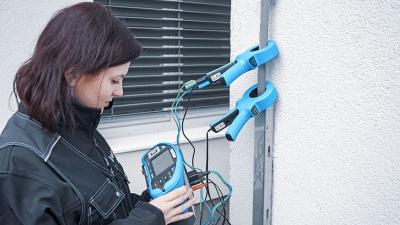Mains bonding and touch voltages during fault current
Hospital earthing and lightning protection

Equipotential bonding is a system that lowers potential differences in an installation by bonding the conductive parts together and to protective earth. It is possibly the most important safety measure in an installation. The earthing system is meant to shorten the duration of the hazardous voltages, while equipotential bonding lowers the voltage differential between points of contact during a fault. Any conductive surface or item should be considered for bonding, regardless of its relationship with electrical installation. Parts of electrical installation are called ‘exposed metalwork’ while other conductive parts are called ‘peripheral’ or ‘extraneous’.
Examples of the latter include water, gas and heating pipes, metal window and door frames.
The importance of bonding cannot be overstated in risky environments, like in presence of water. Non-distilled water is good conductor and can carry stray voltage or current to unexpected spots. A potential difference between metal parts of a building incorporating a bathing pool and a swimmer could occur and rise to dangerous levels. The swimmer’s wet skin has a lowered resistance making them even more susceptible to dangerous leakage currents. No exceptions are allowed for bonding in wet locations, every single conductive surface must be connected.
Equipotential bonding at installation level is generally not considered separately from the rest of the safety measures. Tests that cover it include loop testing, continuity and touch voltage measuring, and testing with the Metrel Human resistance probe A 1597. Loop impedance measurement, also called earth fault loop impedance test or just loop test, passes current in a loop between line and PE wires to measure its impedance and calculate the potential short-circuit current. It is most commonly performed at the switchboard, where line, neutral and protective earth wires are accessible. Potential short-circuit current is calculated to assist selection of correct overcurrent protection.There are multiple guidelines for protection sizing, but to conform to equipotential bonding requirements, it has to disconnect at 50 times smaller current within 5s. In context of equipotential bonding, a similar test is performed: a current is passed into the bond, through the protective devices like fuses and RCDs, and the earthing systems to which it is connected. The measured impedance must be low enough to conform to equation: R ≤ 50/Ia, where Ia is the current that ensures the operation of the protective device within 5s. The measurement is usually performed along with earthing system tests, between earth bonds or electrodes and the measured item.
Human resistance probe A 1597 can be used to measure touch voltage, which is closely connected to bonding resistance. Touch voltage is the voltage between the item and the earth when considering the resistance of the human body in parallel to it. Measuring it gives a direct estimate of danger to life at the location.
Measurements
It is important that in selecting an overcurrent or other protective device that it has sufficient power breaking capacity.
Metrel’s flagship MI 3155 only uses 200 mA for continuity measurement, which is enough for most indoor applications. R Loop function is a high current loop test injecting about 6 A and can be used for larger distances. However it is always best to use the 4-wire method for measuring low impedances.
MI 3155 has pre-programmed tests with automatic disconnection of protective devices. The measurement is 4-wire: two probes connect to the measured surface and two to protective earth in the closest switchboard. This method enables high accuracy even at low current and automatically compensates for test leads resistance. It also automatically reverses polarity to compensate for any material asymmetry and electromechanical effects.
To achieve higher accuracy or measure longer cables, the MI 3242 is a good choice. It uses 4-wire method with a 2 A test current, supports automatic switch of polarity and other methods to improve result. It however doesn’t cover automatic disconnection.

















